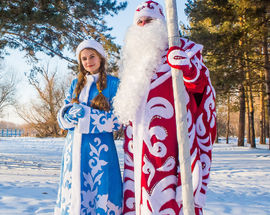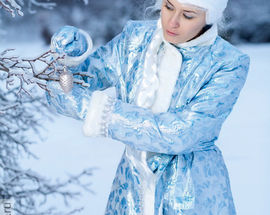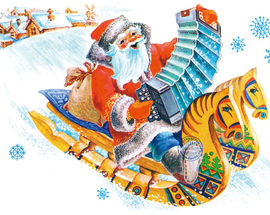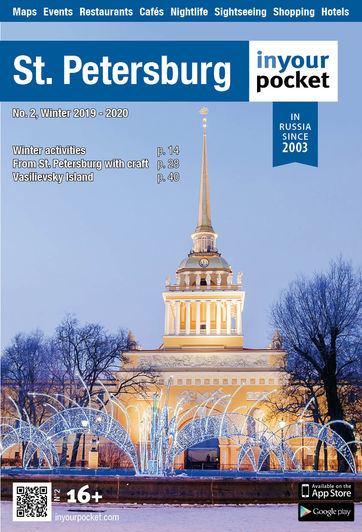Russians love their heroes. Just as with European folklore traditions, Russian tales feature traditional heroes whose kindness, bravery and loyalty are rewarded. In Russian folklore you’ll also find some dark and complex characters like Baba Yaga living her house on chicken legs and her male counterpart, Koshchey the Deathless, an immortal shapeshifter and habitual wife-stealer.
Fitting all of Russia’s beloved folklore heroes into one feature is an impossible task. So because it’s winter, we’ve decided to tell you all about the characters that make the holiday season in our country a truly magical one!
All about Snegurochka and Ded Moroz
New Year in Russia would not be what it is without these two. Ded Moroz is the Russian equivalent of Santa Claus but unlike in Western folklore, Ded Moroz goes around the country giving out presents with Snegurochka (Snowmaiden), his granddaughter and assistant.The original Russian gift-giver was Saint Nicholas, the country's Patron Saint, whose Feast Day is celebrated on December 6th. The image of Saint Nicholas originates from the image of another hero – the ancient Morozko. In Russian folklore Morozko is a powerful hero and smith who chains water with his “iron” frosts. Morozko was not hostile to people - he helped them and gave them lovely presents.
There are several characteristics that differentiate Ded Moroz from Santa Claus - and we’re not just talking about an endorsement from Coca Cola! His shirt and trousers are made of flax and are usually decorated with white geometrical ornamental patterns; his fur coat is ankle long and embroidered with silvery stars and crosses; his hat is normally red and adorned with pearls. Other features of his attire include luxurious high boots with silver ornamentation (or traditional valenki on an exceptionally chilly day) and his pikestaff made either of silver or crystal.
Like a real Russian aristocrat, Ded Moroz rides in a troika – a sleigh pulled by a trio of three white horses representing the three months of winter. This means that Russian children do not have to know the names of all 12 of Santa’s reindeer by heart. Plus, their task of remembering the names of Ded Moroz’s horses was made easy for them by a popular children’s song “Tri Belykh Konya” (“Three White Horses”).
The origins of Snegurochka, Ded Moroz’s gorgeous and virtuous companion who follows him to his New Year parties and helps him interact with children, are contradictory. Some believe the roots of this character to be found in Slavic pagan beliefs. According to legend, she is the daughter of Father Frost and the Snow Queen.
Others, however, do not believe that Snegurochka has roots in Slavic mythology and only came into being in the late 19th century - nonetheless she appears to be as eternal as Russia itself. They believe that this winter beauty was the brainchild of one of Russia’s most significant playwrights and Kostroma Region native, Alexander Ostrovsky. He was partly raised by a nanny who filled his days with fairy tales and it is widely believed that she was the one who gave him the inspiration to bring Snegurochka to life.
Ostrovsky’s play “The Snow Maiden” (first performed in 1873 featuring music composed by Tchaikovsky), portrays the young beauty as the daughter of Frost and Spring. She is immortal and she lives in her father’s winter forest, yet Snegurochka is lonely and would happily give up her immortality for the ability to feel love, like normal humans. By the reign of Nicholas II, Snegurochka had become associated with winter holiday celebrations.
Snegurochka has since been an essential part of the New Year’s celebrations and a helper to Ded Moroz. Young, beautiful and smiling, she always travels with Ded Moroz on a horse-drawn sledge (troika) to visit children and give them gifts. Nowadays, Ded Moroz is considered to be her grandfather rather than her father, as in the old legend. Snegurochka is often depicted with snow white skin, deep sky-blue eyes, cherry lips and curly fair hair. Her present day costume is blue, red, white or silver and her crown is sometimes replaced by an embroidered cap with fur edging.
Believe it or not, there was a brief period in Russia’s recent history when children had to spend New Year without Ded Moroz and his Snegurochka! The arrival of the Bolsheviks to power saw a total revolution in many aspects of people’s lives, including who to believe in during the magical holiday season when anything should be possible. In 1917, Ded Moroz was banished into exile. He was considered a kind of a kids’ god, which was impermissible during Soviet times when Russian leaders were flatly against any manifestations of religiousness.
Thankfully, only 20 years later Ded Moroz returned to the country and New Year’s celebrations became public. Since then Ded Moroz and Snegurochka appear on New Year’s Eve, putting presents under the fir tree for the kids to find in the morning.
Visiting Snegurochka and Ded Moroz
While Santa Claus is rumored to have residences in Finland and the North Pole, Ded Moroz is a proud patriot and maintains a home in Veliky Ustyug in the Vologda Region. His estate is also major tourist attraction receiving more than 200,000 guests a year.Snegurochka, however, is a native of Kostroma so it is not hard to find her in this town just a few hours’ drive from Moscow. She is so beloved in her hometown that her birthday is celebrated in an official capacity for two days. You can meet her in Snegurochka's Fairy Land, located in a restored 19th century building near the waterfront. Snegurochka welcomes guests and explains the uniqueness of regional folk traditions and presents other characters from Ostrovsky’s story. There are large collections of regional costumes and dolls and handicraft classes for young children. Read more here: www.dedmorozz.ru.
Morozko, Snegurochka and Ded Moroz in movies and cartoons
In fairy tales Morozko is at times kind and at times evil. In a manner similar to Robin Hood, he is kind towards the hard working and the good-hearted, but extremely severe with the mean and the lazy. In 1964, a movie was made about this classical fairytale. “Morozko” was directed by Aleksandr Rou (a Soviet film director who made great contributions to the fairytale genre) and starred Eduard Izotov as Ivan, Natalya Sedykh as Nastenka, and Alexander Khvylya as Morozko.Once upon a time, there was a woman who had both a daughter of her own, whom she loved, and a step-daughter, whom she hated. One day, the woman ordered her husband to take her stepdaughter out into the winter fields and leave her there to die, and he obeys. Morozko finds her there; she is polite and kind to him, so he gives her a chest full of beautiful things and fine garments. After a while, her stepmother sends her father to bring back the girl's body to be buried, which he also obeys. After a while, the family dog says that the girl is coming back, and that she is beautiful and happy. When the stepmother sees what her stepdaughter has brought back, she orders her husband to take her own daughter out into the fields. Unlike before, this child is rude to Morozko, and he freezes her to death.
Snegurochka starred in two Soviet films. Director Ivan Ivanov-Vano’s 1952 animated version “The Snow Maiden” is close to Ostrovsky’s version and includes Rimsky-Korsakov’s music. Another version is Pavel Kadochnikov’s “Snegurochka” released in 1969.








Comments